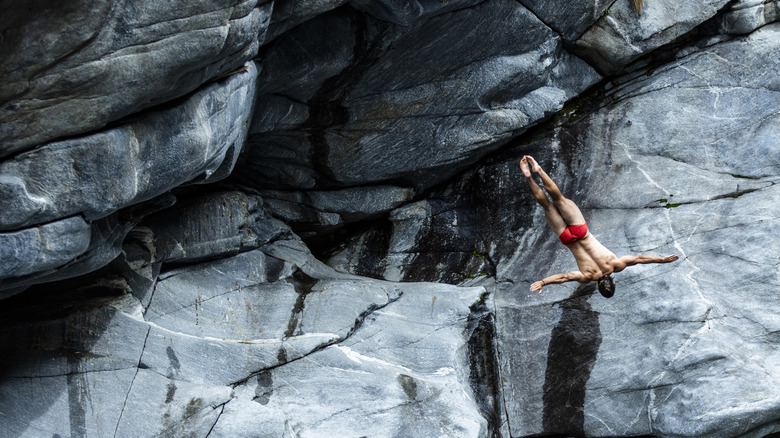Why Tourists Should Avoid Participating In This Dangerous, Albeit Popular, Outdoor Sport
There are at least two types of people in this world: One type wants to dive off a high cliff into water, and the other type does not. The cliff diver sees a natural pool or lake and demands to know how deep it is. If that wall of rock is, say, 40 feet high — at the most — it's perfectly reasonable to leap off the edge, headfirst, into the water below. If even a single person has done it before, cliff divers shrug their shoulders and think, "Meh, should be fine." Heights and human error don't worry the cliff diver. The important thing is the adrenaline rush, impressing passersby, and maybe blowing up on TikTok.
Most people are fully aware that this is a risky idea. The moment we see a stone slab looming over a gorge, our survival instincts kick in. "Nope," we think. "All good." We remember that age-old advice from childhood: "If everybody else jumps off a bridge, that doesn't mean you have to." Even if the swimming hole seems well-trafficked, even if we watch other people dive and survive, even if we ourselves are seasoned divers, we are fully capable of resisting peer pressure. There are lots of terrible ways to die, and crushing our skulls on an unseen boulder sounds like a great example of one.
But then there's a third type: The person who's on the fence. Cliff diving does look pretty awesome. It also looks kind of fatal. Fun, or paralysis? Thrills, or head injuries? What to do, what to do? Since cliff diving is considered an extreme sport that can absolutely kill you, our advice is: probably don't.
Dangers and alternatives to cliff diving
The dangers of cliff diving are manifold. There's the height: Studies have suggested that "hands-first" divers start feeling adverse effects above about 40 feet (as reported by New Scientist). And while water is theoretically soft, a human body falls faster the farther it moves through space, so instead of splashing pleasantly into a pool, the surface will feel more like concrete. This is why people who have jumped off the Golden Gate Bridge from its highest point — 746 feet — generally died on impact, or else were immobilized by shock.
Another danger is the depth of the water. Murk and froth can make this difficult to gauge, and rogue rocks or trees might lurk just below the surface, beyond view. Then there's the possibility of a bad launch; the cliff itself might be wider than you expect, and slipping at the last second could cause serious problems. Even if you land perfectly, ocean waves and roiling rivers complicate your recovery, since you have to adjust to powerful currents. These are the factors that make these cliff diving spots the scariest in the world.
But what about cliff jumping? This approach is much more reasonable, as you're falling feet-first. You could still hurt yourself if you hit a hard surface or belly-flop from a great height, but you're less likely to damage your brain. Many "swimming holes" around the world are famous for this, like Water Wheel Falls in Arizona, which is considered one of the state's best water hikes. These jump-offs are well established, and they're often crowded with visitors who can show you how it's done. With caution, this shouldn't be any more dangerous than a backyard pool — so you can leave actual diving to the pros.

